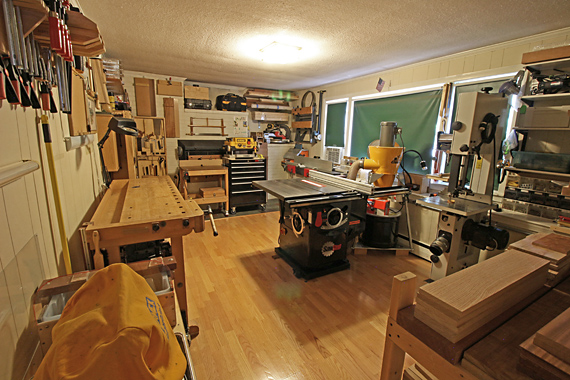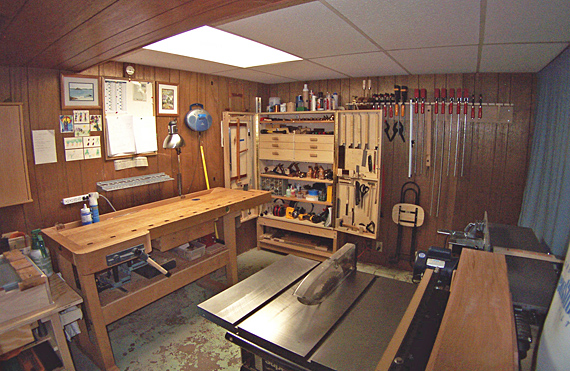
Looking back at photos of my shop as it was 16 years ago (below), I was struck by the differences from now (above). For example, all of the major machines have been upgraded, and I had yet to install most of the shopmade workbench features that now seem essential. Just as interesting, however, is the persistence of effective shop systems. For example, my sharpening bench is essentially unchanged, even in its location alongside the workbench, despite the whole shop being in a different location.
Now to my advice: Let your shop evolve.

By all means, sure, take your best shot at the initial set up, using your resources of space, money, time, and knowledge. But don’t get seized with paralysis by analysis, especially from drooling over dream shops in magazines.
There is no dream shop. There’s your shop, and you need to set it up and start building things in it as soon as possible.
In time, it will become evident what works and what changes are needed, based on what you build, your style of working, and the available resources. At any time, it is impossible to think through every contingency. Better to get going, and let it evolve.
In this way, you will have something better than a dream shop. You will, with persistence and some luck, have a real shop – your shop – and it will be right for you because it will change with you.
My first “shop” after leaving the home of my youth, was a Workmate in a hallway, tools stored in cardboard boxes, and wood stored in a stairwell. Yet I built. Check out Fine Woodworking #237 (Tools and Shops, Winter 2014) for the layout of my humble shop many years later. Of course, however, some features have evolved since then. The photo here at the top is more recent.
We’re all, always, setting up shop – because we woodworkers love to build things.


Great advice. To learn you must do.
Love the article! I have recently moved from a large home and shop ( 1000 sq ft shop) Now I am trying to determine what size shop I should build. The last shop was big spacious and nice,but I don’t think I need that space any more.I love your shop and have since finding and following your blog.
My question is ,what are the dimensions (including ceiling ), and is there anything that (do to size) you have not been able to produce.Also is there anything you really wished you had,but there just isn’t enough room for?
thanks
Thanks, John.
L&S: It’s roughly 11′ x 17′ plus some nooks, and the ceiling is 7’6″. With a little creativity, I’ve been able to make what I want in these small shops, including large bookshelves and beds, though my work is usually small to medium sized.
I’m sure if I had another 200 sf I could fill it up with a wish list but I really don’t feel lacking now. Yea, it’s a bit of a hassle to move machines more than I’d like, especially the jointer planer. But on the other hand, that forces me to think through processes and work efficiently. Yea, I wouldn’t mind having a wide drum sander. Oh, and a bigger workbench. And a dedicated assembly/finishing table. Oh, and a . . . You get the idea.
The main thing is to work with what I have and build stuff.
Rob
Thanks for the feedback Rob
Thanks for the guidance re evolving over time. I am also finding that with my combination of garage space (small, one car size) and basement area, I need mobile tool centers because I work more in the garage in the warm months, but can’t leave the tools there through the winter, due to rust potential. (I’m in Virginia). Thanks for your blog!
Sounds good, Bill.
Mobile machines make all the difference when space is limited. For help with rust issues, I’ve found nothing better than Corrosion X. Though it seems to be left out of most rust protector reviews in woodworking sources, it has a very impressive resume of users (e.g. US Navy, Air Force One, etc.) and other reviews.
http://www.corrosionx.com/marine.html
Rob